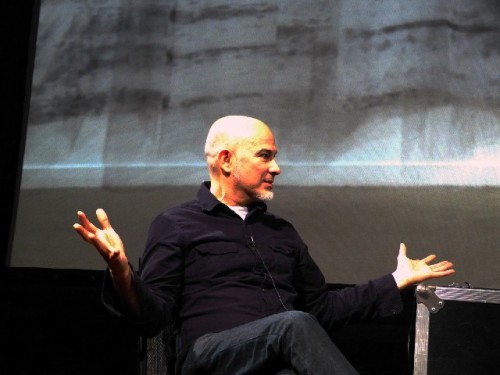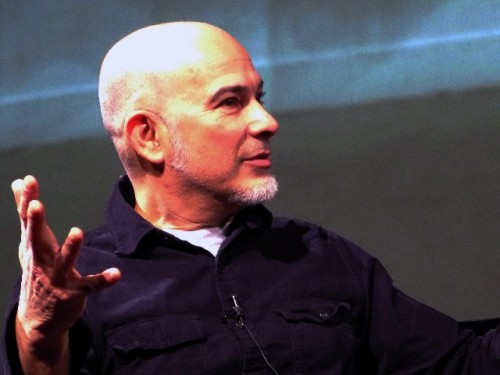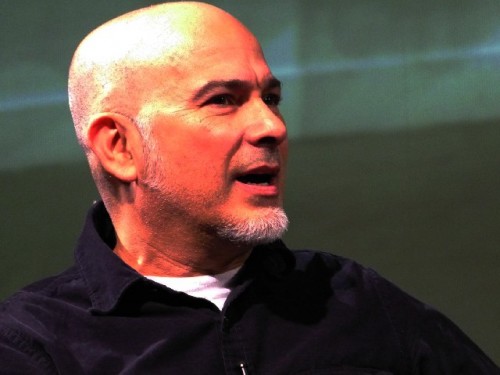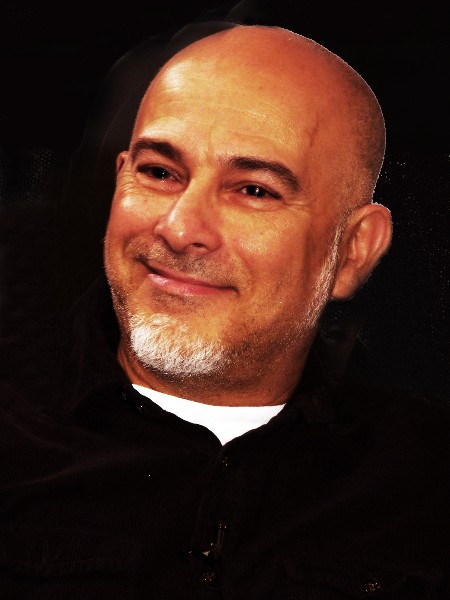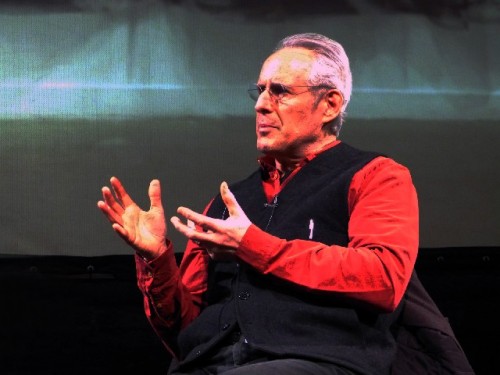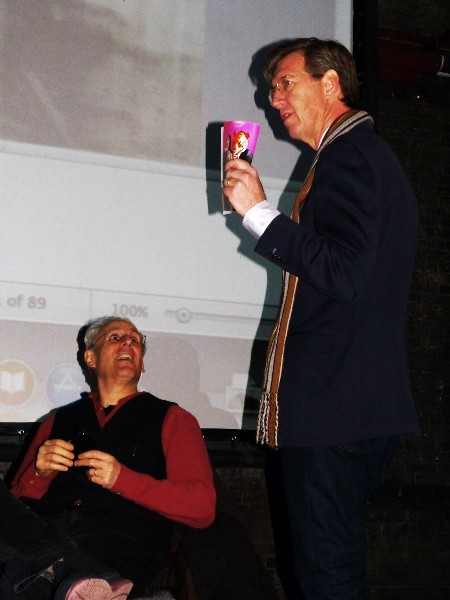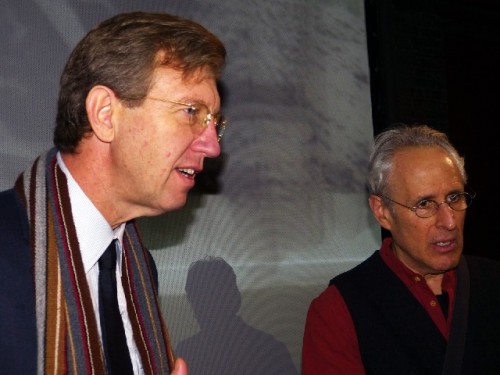Israeli Izhar Patkin Debates Jewish Art
Secular Narratives When God Is Dead
By: Charles Giuliano - Jan 21, 2014
On Saturday, January 18 as programming for the exhibition Izhar Patkin: The Wandering Veil there was a well attended dialogue between the artist and his long time supporter David Ross, now an independent curator, critic and musician formerly the director of the Whitney Museum and previously the Institute of Contemporary Art Boston.
It was a free flowing, unscripted conversation with twists and turns. At one point Ross read from the poetry of Agha Shahid Ali who collaborated with the artist.
In media res Ross raised one of the basic questions of modernism, is there a Jewish art? At this point in the 21st century, with such a great legacy of so many and diverse Jewish artists, or critics/ curators like Ross himself, it was curious. Patkin deflected it, as he often does with topics that annoy or don’t interest him, asking Ross how can you even ask that question?
That elicited a smile from Ross. But the issue was woven back in later with references to Patkin’s Veils as like the Veil of Veronica or the Shroud of Turin. It opened the issue of icons and iconography as well as the Biblical prohibition against the Graven Image.
It is not the kind of question one would ask an American born, Jewish artist. Interestingly, it is the theme of the book and play My Name Is Asher Lev a novel by Chaim Potok, an American author and rabbi. It tells the story of a boy from a Hassidic family who take lessons from a figurative Jewish artist and even paints a crucifixion. As did the Russian born, Marc Chagall, in his 1938 White Crucifixion. Uniquely, instead of a generic loin cloth Christ is wrapped in a traditional Jewish shawl.
Since the question was raised but diverted perhaps a better question might be “Is there an Israeli art?” As a student exploring art most of what Patkin learned about the traditions of Western Art came from books. The training he received was primarily in the Bauhaus traditions of design and abstraction.
While Israel was founded as a secular, democratic nation it was populated by Europeans who brought their traditions of religion, food and customs creating a complex cultural mix. Over the ensuing decades a conservative, fundamentalist minority has moved the State of Israel ever further away from secular neutrality to religious orthodoxy.
We wanted to know how that phenomenon, an outsider’s interpretation that Patkin does not agree with, informs and motivates him as an artist.
Charles Giuliano David has been trying to pin you down on the issue of Jewish art and Judaism with no luck.
Izhar Patkin And you think you will be more successful?
CG I’m going to try a different approach so let’s see what happens. You grew up in Israel surrounded by fundamentalism.
IP No.
CG Let me rephrase that. The entire Middle East is fundamentalist.
IP I don’t agree with that either.
David Ross (with a microphone for those who can’t hear the question.) Charles is trying to frame the question and Izhar is pushing back which is typical of both of them. Charles is saying that you grew up in a place surrounded by fundamentalists. Israel is a place surrounded by Arab nations who are involved in a fundamentalist relationship to Israel. Is that what you mean?
CG Yes. I was born Italian/ Irish American but I don’t call myself Catholic. I was born Catholic. In what sense is being Jewish a religion or is it a nationality. What is it? In that sense has secularism been an aspect of the liberation of your work? Is that possible? We are trying to get at the issue of Jewishness and art. Is it a relevant question or not? One does not ask an Italian American artist if he is Catholic but one assumes that question when the artist is Jewish. You have stated that you are a non practicing Jew.
IP I do not believe in God.
CG To what extent is that informing the work? Is it an aspect of where the work is coming from?
IP To a great extent. Because if you don’t believe in God you can look at those stories about God in a very serious way. How they are structured. The beauty of them. The greatness of them. They’re just another story. They are important in every culture. Not being tied down to any one of them allows you to enjoy some of them.
DR So the literature that come from be it Judaism or Christianity or Islam is not in a hierarchy with any other narrative out there.
IP No, it’s not. There are deeper narratives. Narratives that control our lives in a way that we’ve forgotten. We live in a Gregorian (Christian) calendar for God’s sake. Why should Jews live in a Gregorian calendar? We use words and we don’t know their etymology anymore. Religions that we don’t know where they came from.
DR There are core aspects of civilization where they may have come from. We have the same things around the world.
IP Scientists are looking for a tiny particle.
DR The God Particle.
IP Couldn’t they come up with another name? It’s a simple as that. When you enter these stories and their structures you actually make great discoveries. Last week I was reading one of the scientists involved with researching the discovery of the world from inanimate to animate. For a long time the discussion in the scientific world was about content. About DNA. He said what contained the DNA was the membrane. Maybe the world began with the fat that repelled itself from water. By evolutionary chance it caught a little bit of RNA or DNA. And that’s how it started. So you look at that story and it is almost a religious story. Right?
DR Especially these days you could form a religion around that.
IP There is a book that tells that the Madonna herself is a membrane where the word of God impregnated through her. So there are so many ways of reading these stories. If you look at them without being tied down. There is the indoctrinated part of it and you can see it in different ways.
DR You really are a modernist and not a post modernist. You jump in with both feet.
IP When I came to New York the big story was the distance between the artist and the work. The opacity. The irony. It didn’t feel good to me. I wanted to have no distance from the work. I look at my dog and he’s in the present. Strangely enough I was recently reading a religious article about it’s ok how we eat animals because they only live in the present. So I look at my dog and think, oh my God, he only lives in the present. Which let’s me back into the world. The Veils are in the present. They are ethereal but also present.
DR The Veil is also a shroud. Is also a code.
IP Most of the paintings are really paintings. Like painting the landscape. They’re rectangles. So there’s both.
Question Can you talk about how the Veils are done? Are they painted on a flat wall?
IP The images are worked on with Photoshop. There are many many images that we pull together to create the picture. I had a special printer invented for me that can print three dimensional materials.
DR If you go to the website you can see the machine. (I tried with not luck including a Google search.) It took nine years to develop.
IP Twenty.
DR It’s complex and breaks down a lot. It shouldn’t work because it’s much too big.
IP The machine allows me to hang the Veils and print them as you see them. With their natural gravity. With the pleats. The printer prints directly onto them. I could never print them flat and then hang them up. They are printed on tulle which is called Illusion. The technology didn’t exist back then. (20 years ago when he created the Black Paintings.)
DR This specific tulle which he uses is called Illusion. When he went to buy it he tried to explain to the guy why he wanted these huge swaths of tulle. That must have been interesting.
IP It was very surreal. He said in this country we don’t call it tulle we call it Illusion. We went to the next step and he asked how much do you need? I said, how much have you got? He said how much do you want? Twelve thousand yards. He said that’s ok how would you like your illusion? I said what do you mean? Do you want soft or stiff? Would you like pink or white? It just went on and on.
DR You have done collaborations. Could you talk about working with Nam June Paik?
IP When I was 14 I went to Europe for the first time. Before that I had looked at art in books and magazines. The Italian renaissance. I grew up in a culture where there was no Christmas and things like that. There wasn’t any Jesus anywhere. Not in the realm where I grew up. It’s just not there. I went to the Louvre and the Rijksmuseum in Amsterdam where I saw Christ on the Cross. I thought what is this doing here? It should be in a church. It was frightening and very disorienting. I wasn’t sure it was art. I didn’t know what it was. It was very very powerful. Then I went to the Stedelijk Museum where I saw a Nam June Pail piece of a Buddha looking at himself on a TV monitor. I thought, this is perfect. When I grow up I want to be like this. Then I saw a Mondrian. I thought this is the best art in the world. It’s an oil painting and it doesn’t have any crap on it. It has cracks so I thought it was very authentic.
Later, Nam June and I were in a Whitney Biennial together. He was a little lazy. So he was always looking for people.
DR Young people to do the work. You were a boy genius.
IP He asked Holly (Solomon) to introduce us. He said tomorrow you come to my studio and we’ll collaborate. It was a moment in his life when he was embracing the Korean side of him. It pushed him over the edge with that. We started a piece that was combined Chinese Buddhist and Jewish. He came to the studio to paint on the object and he was very sick. He had diabetes and couldn’t walk well.
This is another interesting thing about religion. (He looked at me picking up our prior dialogue.) He said you have to give me a stool because I can’t stand up for very long. He said The Buddha has punished me for all I have done to him. So I said, fuck you, why are you getting me involved in this? He said, the Buddah can’t touch you. You’re Jewish. Which is profound. Right? It’s true.
There was a generic final question which the artist vaguely responded to. Briefly I interacted with Ross who did not attend the reception. It was snowing and he and his wife Peggy opted to drive back to their home in Beacon, New York. I have known Ross for decades since he was director of the ICA. We have had interesting and at times contentious exchanges. But I was surprised when he said to me pointedly “He put you in your place.” I didn’t see it that way and responded “I don’t regret asking that question.” To which Ross replied “It’s your job.” During the reception I approached the artist for some follow up.
Charles Giuliano I didn’t get anywhere with that question but would still like to pursue your work as an Israeli.
Izhar Patkin I was born in Israel and left. Now I am an American. So what does that make me?
CG At what age did you leave?
IP I’m bad with years but I left what 30 years ago.
CG You were fairly formed.
IP I was young.
CG I’m trying to get a sense of how that heritage, experience and the politics you walked away from are factors in the work. Embracing the work there is the sense that there is a powerful force behind it so I am trying to understand that trajectory.
IP I am still linked to that country. You asked what it means to be Jewish? For my generation speaking Hebrew is the main glue. It’s the glue that holds it all together. I still read Haaretz which is the leading newspaper. Does it make a difference if I read it on the internet in New York or Tel Aviv? No.
CG Can one be secular and live in Israel?
IP Sure.
CG Israel was formed as a secular state. But it seems to be gravitating to becoming more and more…
IP It’s becoming more and more religious. More and more children are in the religious school system. The government is becoming more and more righteous and all that. Israel is becoming messianic.
CG As I was trying to say that’s true in the entire Middle East but you were denying that.
IP Yes and no. You can’t globalize it. My friend is Palestinian and he has a foundation called Telos. They take faith based visitors to Palestine and Israel. It opens them up into a bigger narrative that involves living people. So we can’t go with those images.
(From the Telos website “Telos strengthens the capacity of American faith communities - and especially American evangelicals - to help positively transform the Israeli-Palestinian conflict. Our vision is security, freedom, and dignity for every human being in the Holy Land, and our belief is that a two-state solution supported by the United States is the only viable way to realize that vision. In other words, we at Telos are genuinely pro-Israeli, pro-Palestinian, pro-American, and pro-peace, all at the same time.”)
CG Your project with a Pakistani poet (Agha Shahid Ali) what’s behind that? It seems to be a dialogue between two cultures about clashes and conflicts.
IP He also lived in Brooklyn.
CG Is there some way of connecting that?
IP You’re looking for an arc as a journalist.
CG Of course.
IP And I’m sorry I’m not able to provide it.
CG That’s fine too. It’s also an answer.
Astrid Hiemer In addition to that question you’re an immigrant. I’m an immigrant. I grew up in Northern German in Hamburg. So clearly we bring our past into this country.
IP We bring our food and culture.
AH We bring our families and background. That has to be expressed in some way.
IP It is expressed. I’m not putting it behind me or denying it.
AH You are saying that through globalization it becomes more expressed and more flat.
IP What’s happening with globalization now is a flattening.
CG Do these questions follow you? Am I a typical journalist in asking them? Do you run into this?
IP It’s been asked a lot.
CG Do you resent being asked?
IP No. I try to understand what is the undercurrent behind the question. What am I really being asked?
CG Do you feel I have an undercurrent?
IP No. I don’t know.
CG I don’t know either. I’m just trying to have an understanding.
IP When you put out on the table that the entire area is fundamentalist I can’t just nod my head. Because I have plenty of friends who are not. And yes, fundamentalism is rising. It’s rising in this country too. It’s rising all over the world. Even in God Damned Holland. I don’t know how to respond to a question like that.
CG That’s valid.
IP Yet, do I feel defeated in this issue? (emphasis) Yes I do. The Geneva Initiative, if you know what it was, The Geneva Accord, all the meetings, which was a meeting between Israelis and Palestinians, happened for two years in my studio in New York.
(Wikipedia “The Geneva Initiative, also known as the Geneva Accord, is a draft Permanent Status Agreement to end the Israeli-Palestinian conflict, based on previous official negotiations, international resolutions, the Quartet Roadmap, the Clinton Parameters, and the Arab Peace Initiative.
“The document, was finished on 12 October 2003. The Accord was prepared in secret for over 2 years before the 50-page document was officially launched on 1 December 2003, at a ceremony in Geneva, Switzerland. Among its creators were formal negotiators and architects of previous rounds of Israeli-Palestinian negotiations,including former Israeli minister and politician Yossi Beilin and former Palestinian Authority minister Yasser Abed Rabbo. Both noted that the Geneva accord did not obligate either of their respective governments, even though Abed Rabbo was a minister at the time of writing. The Initiative got broad international support, but was heavily criticized by Israeli Prime Minister Ariel Sharon.
“In September 2009, a detailed expanded version of the plan was released.The annexes serve as a supplement to the Geneva Accord, outlining the practical measures required for successful implementation of the two-state solution. They cover key issues including security, border crossings, the Implementation and Verification Group (IVG), roads, water management, environmental concerns, the economy, and the division of Jerusalem.” )
All the public meetings. I was flying high. We were really getting somewhere.
Do I feel defeated? yes.
Review of Mass MoCA Exhibition.


